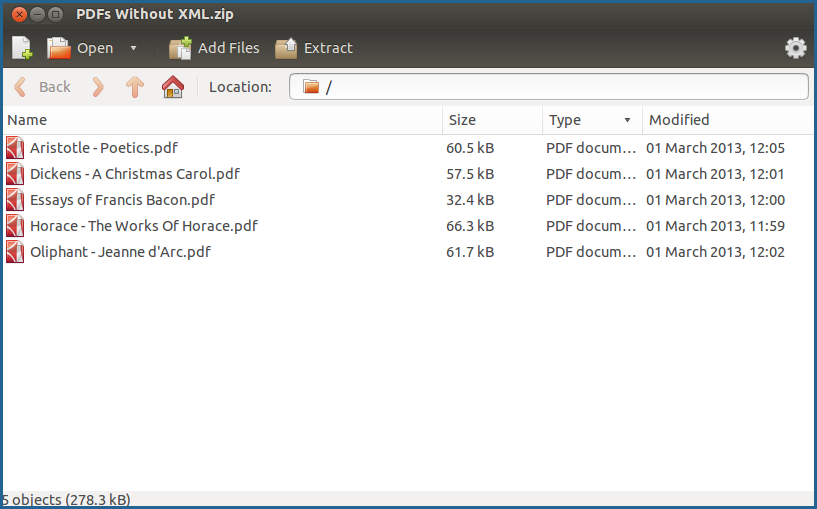...
For larger collections, Islandora is able to pull multiple files out of a zipped archive and ingest them into Fedora as a batch. There are a few ways that this can be done. You can upload .zip archives full of:
- content files to be ingested
- XML metadata that can later have file datastreams content files added to it
- both content files to be ingested and XML metadata to be appended to files
- books, formatted with a specific directory structure
...
Ingesting files from a .zip archive without metadata
1. Create a .zip archive
...
with your files in it
The process for doing this will vary from operating system to operating system, but on PC, Mac and Linux at least, a .zip archive can be made in your file browser by highlighting all the file or files you would like to zip, right-clicking, and finding an option similar to 'compress', 'create archive', 'create zipped folder', and so on.
In our example, opening the zipped archive shows our PDFs grouped together:

2. Navigate to the destination collection
...
and click 'Manage'

This will take you to the collection's management page.
...
- Browse to the .zip file you would like to upload, and then click the 'Upload' button. It may take a while to move the file to the server.
- Choose the content models you would like to apply to the objects.
- Choose the namespace to be applied to the objects. ("Islandora" is given only as an example.)
- Click the 'Import' button to begin the batch import process.
This will import all the files from your zipped archive into the during which new Fedora objects are created and associated with the specified collection.
Ingesting metadata from a .zip archive
...
In our example, a .zip file full of XML files has been created - one for each PDF we had uploaded in the previous example. Once the metadata files are fully ingested, PDF files can be added to the objects as datastreams.

In this case, we can simply follow the exact same steps as in the previous example to perform the batch ingest.
...
To create the XML files, you can either design them manually in a text editor or XML editor , or use the Form Builder built into Islandora.
...
Fill out the form with the metadata values you would like, and click the 'Submit' button at the bottom of the form. This will output raw XML to your browser that you can then paste into a text editor, similar to the following:
...
Ingesting files and corresponding metadata from a .zip archive
Archives Zip archives can contain both the content files to be ingested and the metadata records to be applied to themfiles at the same time. This can be accomplished in the same way as the first example, with a few changes to the .zip archive itself:
...
In the above example, you will notice that each PDF file has a corresponding XML file, and that the name filenames of the PDF PDFs and the XML files are identical in every way – including capitalization – except for the extension. XML files will only be appended as datastreams to objects when their filename perfectly matches that of the object - including capitalization.Files with matching filenames will be ingested together into the same object.
After creating a .zip archive like above, you can simply follow the steps from the first example to ingest the batch into the repository.
...


